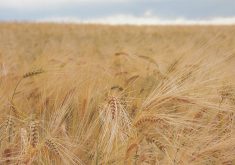Winnipeg | Reuters — Canadian farmers will harvest less wheat than expected after dry conditions in parts of the Prairie provinces shrunk yields, a government report showed on Tuesday.
Drought is expected to send global wheat stockpiles for major exporters to the lowest levels in more than a decade, a Reuters analysis has shown.
Canada is the world’s fourth-largest wheat exporter and the biggest shipper of canola, which is used largely to produce vegetable oil.
Statistics Canada estimated all-wheat production at 29.5 million metric tonnes, the second-lowest in eight years, and down 14 per cent from last year (see table below). The estimate fell below the average industry expectation of 30.4 million in a Reuters survey.
Read Also

U.S. grains: Corn futures lower as farmers sell, soy choppy
Chicago corn futures ticked lower on Tuesday on selling pressure as soybeans chopped up and down, though expectations of a bumper U.S. harvest limited the upside in prices, analysts said.
“We’re down significantly. We’re seeing a tightening (of supplies) in the major exporters,” said Bruce Burnett, director of markets and weather at MarketsFarm.
Farms in areas of North and South America, Europe and Australia face crop losses as extreme weather spreads over an unusually wide geographic area, making food production increasingly vulnerable.
Production of spring wheat, used in baking, looked to fall 14.5 per cent to 22.1 million tonnes. The harvest of durum wheat, used in pasta production, is expected to plummet 26 per cent, to 4.3 million tonnes.
Farmers look to produce 17.6 million tons of canola, down six per cent from last year. It would be Canada’s second-smallest canola crop in nine years.
The average trade estimate was 17.4 million tonnes.
ICE Canada November canola futures extended gains after the report, rising 0.6 per cent.
Oat production looks to fall by more than 50 per cent to 2.4 million tonnes, Canada’s smallest output since 1991.
StatsCan based its estimates on satellite and agroclimatic data as of July 31, before much harvesting had taken place. It will release new estimates on Sept. 14 using data as of Aug. 31.
— Rod Nickel is a Reuters correspondent in Winnipeg.
Table: Statistics Canada’s estimates of production of Canada’s principal field crops as of July 2023, released Aug. 29, 2023.

For more content related to drought management visit The Dry Times, where you can find a collection of stories from our family of publications as well as links to external resources to support your decisions through these difficult times.
















